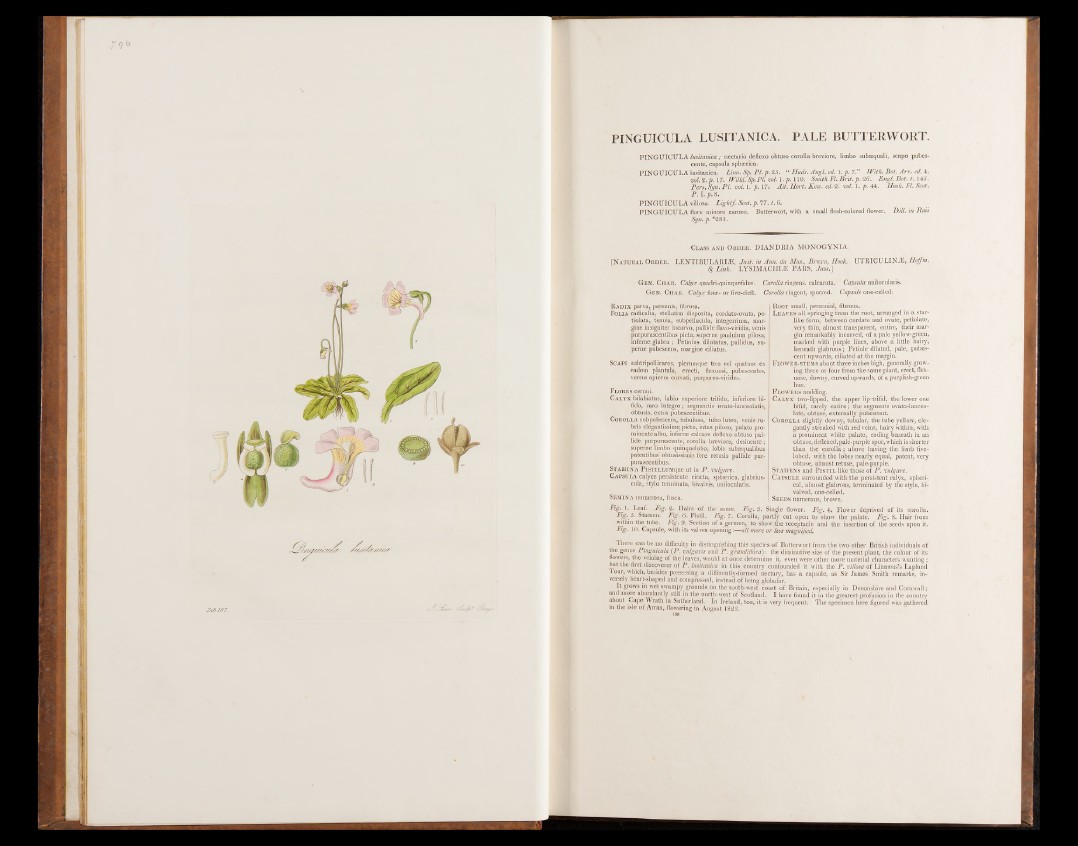
PINGUICULA LUSITANICA. PALE BUTTERWORT.
PING U ICU LA lusitanica; nectario deflexo obtuso corolla breviore, limbo suboequali, scapo pubes-
cente, capsula sphærica.
PIN G U ICU LA lusitanica. Linn. Sp. PI. p. 25. “ Huds. Angl. ed. 1. p. 7 ” With. Bot. A rr. ed. 4.
ml. 2. p. 17. Willd. Sp. PI. ml. 1. p. 110. Smith FI. B rit. p. 26. Engl. Bot. t. 145.
Pers.Syn. PI. ml. 1. p. 17. Ait. Hort. Kew. ed. 2. ml. 1. p. 44. Hook. FI. Scot.
P . I. p. 8.
P INGUICULA villosa. Lightf. Scot. p. 77. t. 6.
P INGUICULA flore minore cameo. Butterwort, with a small flesh-colored flower. Dill, in Raii
Syn. p. *281.
Class a n d Or d e r . DIANDRIA MONOGYNIA.
[N a tura l Or d e r . LENTIBULARIÆ, Jusi. in Ann. du Mus., Brown, Hook. UTRICULINÆ, Hoffm.
8s Link. LYSIMACHIÆ PARS, Juts.]
G e n . Ch a r . Calyx quadri-quinquefidus. Corolla ringens, calcarata. Capsula unilocularis.
G e n . Ch a r . Calyxioux- or five-cleft. Corolla ringent, spurred. Capsule one-celled.
Ra d ix parva, perennis, fibrosa.
Folia radicalia, stellatim disposita, cordato-ovata, pe-
tiolata, tenuia, subpellucida, integerrima, mar-
gine insigniter incurvo, pallide flavo-viridia, venis
purpurascentibus picta, superne paululum pilosa,
inferne glabra ; Petiolus dilatatus, pallidus, superne
pubescens, margine ciliatus.
Sc a p ï subtripollicares, plerumque très vel quatuor ex
eadein plantula, erecti, flexuosi, pubescentes,
versus apicem curvati, purpureo-virides.
Flores cernui.
Calyx bilabia te , labio superiore trifido, inferiore bi-
fido, raro integro ; segmentis ovato-lanceolatis,
obtusis, extus pubescentibus.
Corolla subpubescens, tubulosa, tubo luteo, venis ru-
bris elegantissimq, picto, intus piloso, palato prominente
albo, inferne calcare deflexo obtuso pal- ;
lide purpurascente, corolla breviore, desinente ;
superne limbo quinquelobo, lobis subæqualibus
patentibus' obtusissimis fere retusis pallide purpurascentibus.
St am in a PiSTiLLUMque ut in P . vulgare.
Capsula calyce persistente cincta, sphærica, glabrius-
cula, stylo terminata, bivalvis, unilocularis.
Sem in a numerosa, fusca.
Fig. 1. Leaf. Fig. 2. Hairs of the same. Fig. 3. S
Fig. 5. Stamen. Fig. 6. Pistil. Fig. 7. Corolla, ps
within the tube. Fig. 9- Section of a germen, to sho
Fig. 10. Capsule, with its valves opening :—all more c
Root small, perennial, fibrous.
L eaves all springing from the root, arranged in a star-
like form, between cordate and ovate, petiolate,
,very thin, almost transparent, entire, their margin
remarkably incurved, o f a pale yellow-green,
marked with purple lines, above a little hairy,
beneath glabrous; Petiole dilated, pale, pubescent
upwards, ciliated a t the margin.
Flower-stems about three inches high,’ generally growing
three or four from the same plant, erect, flex-
uose, downy, curved upwards, o f a purplish-green
hue.
F lowers nodding.
Ca l y x two-lipped, the upper lip- trifid, the lower one
bifid, rarely entire; the segments ovato-lanceo-
late, obtuse, externally pubescent.
Corolla slightly downy, tubular, the tube yellow, e le gantly
streaked with red veins, hairy within, with
a prominent white palate, ending beneath in an
obtuse, deflexed, pale-purple spur, which is shorter
than th e . co ro lla ; above having the limb five-
lobed, with the lobes nearly-equal, patent, very
obtuse, almost retuse, pale-purple.
Stam en s and P is t il like those o f P . mlgare.
Capsule surrounded with the persistent calyx, spherical,
almost glabrous, terminated by the style, bi-
valved, one-celled.
Se ed s numerous, brown.
ingle flower. Fig. 4. Flower deprived of its corolla,
rtly cut open to show the palate. Fig. 8. Hair from
cv the receptacle and the insertion of the seeds upon it.
r less magnified.
There can be no difficulty in distinguishing this species of Butterwort from the two other British individuals of
the genus Pinguicula ( P . vulgaris and P . grandifiora): the diminutive size of the present plant, the colour of its
flowers, the veining of the leaves, would at once determine it, even were other more material characters wanting ;
but the first discoverer of P . lusitanica in this country confounded it with the P . villosa of Linnseus’s Lapland
Tour, which, besides possessing a differently-formed nectary, has a capsule, as Sir James Smith remarks, inversely
heart-shaped and compressed, instead of being globular.
I t grows in wet swampy grounds on the south-west coast of Britain, especially in Devonshire and Cornwall;
and more abundantly still in the north-west of Scotland. I have found it in the greatest profusion in the country
about v^ape Wrath in Sutherland. In Ireland, too, it is very frequent. The specimen here figured was gathered
in the isle of Arran, flowering in August 1823.